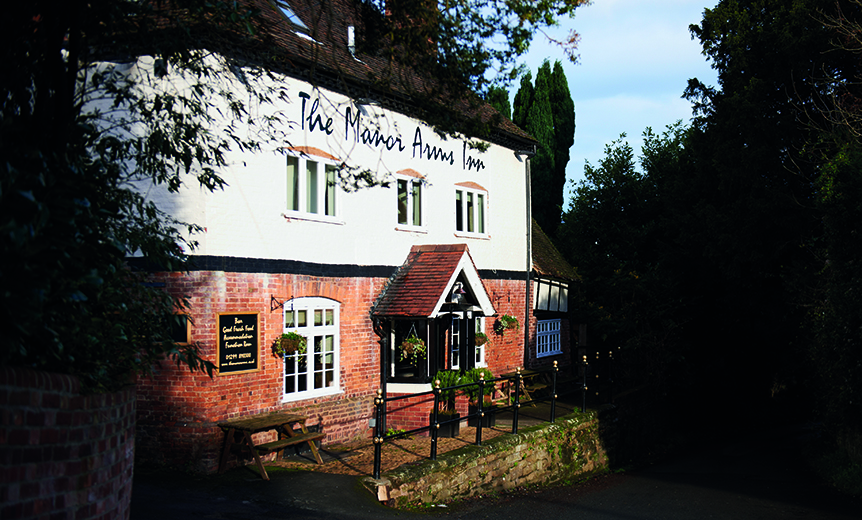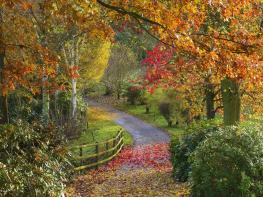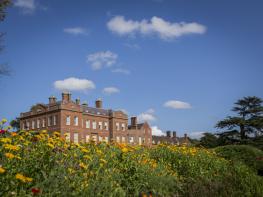In a tiny village on the Staffordshire-Shropshire border, the family-owned Red Lion Inn has…
Kinver to Whittington

Celebrating a success story and remembering a tragedy on this final walk.
3.25 miles (5.3kms)
About the walk
Given the part canals have played in the Staffordshire landscape over the past 250 years, it seems appropriate that the final walk in the book should include at least a short section of artificial waterway, even if it isn’t the walk’s highlight. It seems fitting too, that the Staffordshire and Worcestershire Canal was designed and built under the apparently omnipotent eye of James Brindley, whose name is associated with so many of the walks in this volume, and who perhaps did more than any other single person to shape the landscape and fortune of the county.
Waterway to go
The Staffordshire and Worcester Canal was one of Brindley’s earliest projects; it was officially opened in 1772. Essentially, it was part of his so-called ‘Grand Cross’, a visionary scheme to connect all of the major ports (Bristol, Hull and Liverpool) by linking the Severn, the Trent and the Mersey. The canal begins at the River Severn before rising slowly to Aldersley Junction, near Wolverhampton, where it connects with the Shropshire Union Canal. It then continues as far as the Trent and Mersey Canal at Great Haywood near Shugborough. Its highlight has to be the three-tier lock at The Bratch, near Wombourne.
Turn in here Whittington
Despite James Brindley’s best efforts, the highlight of this walk has to be the Whittington Inn, a timber-beamed manor house built in 1310 that now serves a very reasonable pint – and also has a handy selection of spirits. It was originally owned by Sir William de Whittington, then lord of Kinver, and grandfather of Dick Whittington, who became Lord Mayor of London.
Shades of grey
The house was later inherited by ancestors of Lady Jane Grey, who spent some of her childhood here, before her life was plunged into turmoil. She was fourth in line to the throne in Henry VIII’s will, but thanks to the scheming of her Protestant father-in-law, a royal advisor, she was crowned Queen ahead of Henry's daughter Mary, who was Catholic. She ruled for just nine days, before Mary, with strong popular support, seized the throne and had her imprisoned in the Tower of London. Less than a year later, aged just 16, she was beheaded. During the reign of Mary’s successor, Queen Elizabeth I, Jane was celebrated as a Protestant martyr. Today, her ghost is said to still haunt the inn staircase. Meanwhile, the shade of Dick Whittington has been spotted, in a black coach galloping soundlessly south towards Kidderminster.
Walk directions
From The Vine pub beside Kinver Lock, go up Dunsley Road for 100yds (91m) and turn right along a gravel track (‘Gibraltar’) between houses. In 200yds (183m) bear left up a fairly steep path through woods to the corner of a driveway. Turn up left, and then right just after Dunsley House, along a short dirt and grass track.
At the track's end keep ahead over a stile, with a tall cupressus hedge on your right (it protects a small vineyard). Continue straight ahead from stile to stile across one small field, then down over another small one and two very large ones to a final stile on to the A449.
Take care crossing this fast, busy road, then head left for 110yds (100m), to a stile. Follow the fenced path next to newly planted trees up to the corner of Gibbet Wood. Turn right, following the edge of the wood around to a stile on the left, and then up the wood edge to a rough track, Gibbet Lane. Turn right here for 350yds (320m) and right again over a stile in a high metal fence. Once across the private access road, head down the left edge of the next field. At its foot turn right along a tree-lined track.
At the track end, continue along a fence to your right for 100yds (91m). As the fence bears round to the right, keep going straight on, past a brick pedestal and a lonely stile mid-field, then slightly up over a brow to find a stile beyond. Bear slightly left down the next field to a stile (a gate is on its left), and then cut off the corner of the next field to cross a stile, one more small field, and a stile with a gate alongside. Follow the top, left-hand edge of this final large field all the way to a stile onto the A449 opposite the Whittington Inn.
Cross the busy road here (taking great care) and pass to the right of the inn (footpath sign to Lower Whittington). A small path along an ivy-covered wall leads to a hedged way down between houses to a road corner. Turn right, following a footpath sign, to a field beside the canal. Follow its bank along the field, through some woods and below some canal front houses. Just after them, fork right, uphill, to the driveway corner passed before Point 2 on the outward walk. Bear down left back to Kinver Lock.
Additional information
Grass tracks, field paths, roads and dirt trails, many stiles
Field, meadow, woodland and canalside
Keep on lead in all fields
OS Explorer 219 Wolverhampton & Dudley
At Kinver Lock (walk start); Kinver High Street
Kinver High Street
WALKING IN SAFETY
Read our tips to look after yourself and the environment when following this walk.
Find out more
Also in the area
About the area
Discover Staffordshire
It was Staffordshire that bore the brunt of the largest non-nuclear explosion of World War II, when a munitions dump at RAF Fauld went up in 1944. It was also the county’s regiment that once boasted within its ranks the most decorated NCO of World War I, in the person of William Coltman (1891-1974). Going back a little further, George Handel penned his world-famous masterpiece The Messiah on Staffordshire soil. During another chapter of Staffordshire history, the county was home to the first canals and the first factory in Britain, and it had front-row seats for the drama surrounding one of the most notorious murder trials of the 19th century, that of Doctor William Palmer.
In outline, Staffordshire looks not unlike the profile of a man giving Leicestershire a big kiss. The man’s forehead is arguably the best region for hillwalking, as it comprises a significant chunk of the Peak District. This area is characterised by lofty moors, deep dales and tremendous views of both. Further south are the six sprawling towns that make up Stoke-on-Trent, which historically have had such an impact on Staffordshire’s fortunes, not to mention its culture and countryside. This is pottery country, formerly at the forefront of the Industrial Revolution and the driving force behind a network of canals that still criss-cross the county.
Nearby stays
Restaurants and Pubs
Nearby experiences
Recommended things to do
Why choose Rated Trips?
Your trusted guide to rated places across the UK
The best coverage
Discover more than 15,000 professionally rated places to stay, eat and visit from across the UK and Ireland.
Quality assured
Choose a place to stay safe in the knowledge that it has been expertly assessed by trained assessors.
Plan your next trip
Search by location or the type of place you're visiting to find your next ideal holiday experience.
Travel inspiration
Read our articles, city guides and recommended things to do for inspiration. We're here to help you explore the UK.













